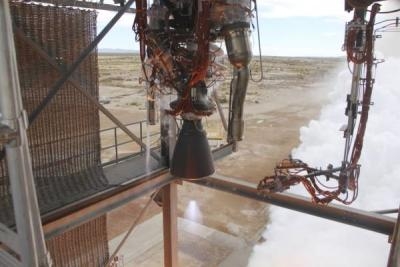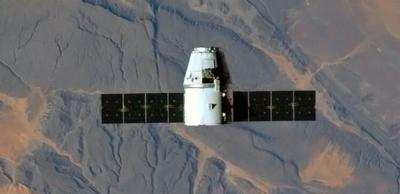All Companies Report Reaching Development Milestones
NASA's industry partners continue to complete development milestones under agreements with the agency’s Commercial Crew Program. The work performed by Blue Origin, Boeing, Sierra Nevada Corporation and SpaceX during partnership and contract initiatives are leading a new generation of safe, reliable and cost-effective crew space transportation systems to low-Earth orbit destinations.

Blue Origin conducted an interim design review of the subsystems in development for its Space Vehicle spacecraft designed to carry people into low-Earth orbit. The September review was performed under an unfunded Commercial Crew Development Round 2 (CCDev2) agreement with NASA. In October, NASA and Blue Origin agreed to add three additional unfunded milestones to the agreement to continue the development work and partnership. Those milestones will include further testing of Blue Origin’s propellant tank, BE-3 engine and pusher escape system (pictured).
"The team at Blue Origin has made tremendous progress in its design, and we’re excited to extend our partnership to 2016," said Kathy Lueders, manager of NASA's Commercial Crew Program. "It's important to keep a pulse on the commercial human spaceflight industry as a whole, and this partnership is a shining example of what works well for both industry and the government."
Boeing successfully closed out its Commercial Crew Integrated Capability (CCiCap) agreement with NASA, which significantly matured the company’s crew transportation system, including the CST-100 spacecraft and Atlas V rocket. Meanwhile, both Boeing and SpaceX began work on the Commercial Crew Transportation Capability (CCtCap) contracts the agency awarded them Sept. 16 to develop systems to transport astronauts to and from the International Space Station while the U.S. Government Accountability Office (GAO) considers the GAO bid protest filed by Sierra Nevada Corporation.
Sierra Nevada Corporation (SNC) continued to perform incremental tests of its reaction control system as it prepares for a CCiCap milestone review for NASA that details the system, which would help maneuver the Dream Chaser spacecraft in space. SNC also is preparing for the CCiCap free-flight milestone test of its Dream Chaser test vehicle at NASA’s Armstrong Flight Research Center.

SpaceX held several CCiCap meetings with NASA, including one in August that covered the company’s launch and mission operations plans and the associated ground systems at Kennedy Space Center’s Launch Complex 39A. The company also held a series of technical interchange sessions with the agency’s spaceflight experts to discuss the intricacies of the progress, testing and plans associated with the Crew Dragon spacecraft and the Falcon 9 v 1.1 rocket.
"Our partners’ detailed progress on launch and spaceflight capabilities expands domestic access to space and does so in a unique and revolutionary manner," said Lueders. "Their success is a critical part of NASA’s integrated approach to advance the frontier of exploration."
With the new CCtCap contracts announced Sept. 16, NASA’s goal is to certify crew transportation systems in 2017 that will return the ability to launch astronauts from American soil to the International Space Station.
(Images from file)
 Bolen Gives Congress a Rare Thumbs-Up
Bolen Gives Congress a Rare Thumbs-Up The SportPlane Resource Guide RETURNS!!!!
The SportPlane Resource Guide RETURNS!!!! Buying Sprees Continue: Textron eAviation Takes On Amazilia Aerospace
Buying Sprees Continue: Textron eAviation Takes On Amazilia Aerospace Hawker 4000 Bizjets Gain Nav System, Data Link STC
Hawker 4000 Bizjets Gain Nav System, Data Link STC Echodyne Gets BVLOS Waiver for AiRanger Aircraft
Echodyne Gets BVLOS Waiver for AiRanger Aircraft




